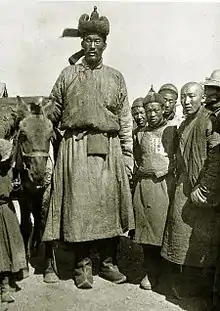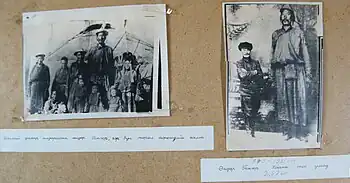
Öndör Gongor (Mongolian: Өндөр Гонгор, "Tall Gongor", c. 1880/85 – late 1920s), whose full name was Pureviin Gongor (Mongolian: Пүрэвийн Гонгор), was a man in early-20th century Mongolia, who suffered from gigantism. He was measured 2.36 m (7 ft 9 in) high by Roy Chapman Andrews,[1] but some other sources even give 2.45 m (8 ft). He is known all over Mongolia, and also mentioned or pictured in some accounts of contemporary western travellers.[2][3]
According to an interview with his daughter G. Budkhand, published in 1997, Gongor was the third child of a herder named Pürev, who lived in the Dalai Choinkhor wangiin khoshuu what is today Jargalant sum of Khövsgöl aimag. He was not particularly big as a child. He only had long fingers. Because he always ate a lot, he became a bit unpopular with his parents, and eventually was sent to Ikh Khüree. One day, he was summoned to the Bogd Khan, given fresh clothes, and after a while he was even made to marry a woman who worked as one of the Bogd Khan's seamstresses on the grounds that their fates were connected at least according to a horoscope by the Bogd Khan. [1]
There is uncertainty around what Gongor's occupation at the Bogd Khan's court was: accountant and keeper of the Bogd Khan's elephant,[1] the Bogd Khan's bodyguard,[3] or wrestler.[2] In 1913, he traveled to Russia with a delegation headed by Sain Noyon Khan Namnansüren. Later, he is said to have worked at the toll office.[1]
Gongor had four children. He died in his home area in the late 1920s, before reaching the age of 50.[1] His corpse is said to have been stolen during the funeral – at that time, the deceased were laid out in the steppe to be devoured by birds and other animals..
One of Gongor's grandsons, D. Davaanyam, is a well-known children's author in Mongolia.[1]
References

